BLOG - Page 27
Recently created mixtures:

Sea-Buckthorn Macerated oil
February 7, 2019

Home made air freshener
June 29, 2016

Homemade Dog-rose distillate
June 28, 2016

Homemade jasmine distillate
June 22, 2016

Moxibustion treatment with Moxa stick
May 30, 2016

Face and body gentle oil cleanser
May 26, 2016
BLOG / LATEST ADDITIONS!
Sandalwood Essential Oil (Santalum Album) ☸ Essential oils ☸ Base / General
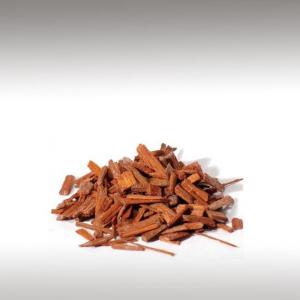

Botanical Name: Santalum album
Common Method of Extraction: Steam distillation
Part Typically Used: Chipped heartwood
Color: Clear with a Yellow Tinge
Consistency: Medium - Thick
Perfumery Note: Base
Strength of Initial Aroma: Woody, exotic.
Sandalwood oil is from India and extracted from Santalum Album of the Santalaceae family and is also known as East Indian Sandalwood, Santal, Saunders and Sandalwood Mysore.
Santalum Album or Indian Sandalwood is a small tropical tree, and is the most commonly known source of Sandalwood. It can take thirty to sixty years for a tree to reach full maturity, when it is cut and distilled.
The plant is widely cultivated and long lived, although harvest is viable after 40 years. Etymologically it is derived from Sanskrit "Chandanam - Sandanam - Sandalum - Sandal".
Sandalwood is an evergreen, parasitic tree that burrows its roots into other trees. It normally grows in sandy or stony red soils, but a wide range of soil types are inhabited.
The height of the evergreen tree is between 4 and 9 metres. They may live to one hundred years of age. The reddish or brown bark can be almost black and is smooth in young trees, becoming cracked with a red reveal. The heartwood is pale green to white as the common name indicates.
The documented use of the wood goes back 4000 years and caravans carrying this wood from India to Egypt, Greece and Rome were a familiar sight. Many temples were built from the wood and the Egyptians used the oil in embalming.
While there are other species of Sandalwood, including Red Sandalwood, Australian Sandalwood (Santalum Spicatum) and New Caledonian Sandalwood (Santalum Austrocaledonicum), these are quite different from true Santalum Album and have very different properties and fragrances.
The heartwood is the most precious part of the Sandalwood tree, and the best heartwood comes from the roots. Sapwood yields a lower quality oil. Older trees have more heartwood, and so are more highly prized.
For each extraction method, the quality of the final Sandalwood oil will depend upon the quality of the wood, the length of distillation time, and the experience of the distiller.
These days, Sandalwood essential oil is extracted primarily by steam distillation, a process in which super heated steam is passed through the powdered wood. The steam helps to release and carry away the essential oil that is locked in the cellular structure of the wood. The steam is then cooled and the result is Sandalwood hydrosol and Sandalwood essential oil.
The oil will improve with age (unlike some other essential oils which degrade with age), and you will likely never be able to replace it.
Sandalwood is used in many different ways in the spiritual traditions of the East. It is used as incense in temples or on personal altars to remind us of the fragrant realms of the heavenly realms. Deities of various kinds are fashioned from Sandalwood, then installed in a shrine or temple or placed upon the home altar.
Meditation beads or malas are made with Sandalwood in which amantra or a personal prayer is repeated as the beads roll through the fingers.
Sandalwood oil is rare and expensive and the price is going up rapidly as the Indian government places tighter regulations on its production and export.
Common Method of Extraction: Steam distillation
Part Typically Used: Chipped heartwood
Color: Clear with a Yellow Tinge
Consistency: Medium - Thick
Perfumery Note: Base
Strength of Initial Aroma: Woody, exotic.
Sandalwood oil is from India and extracted from Santalum Album of the Santalaceae family and is also known as East Indian Sandalwood, Santal, Saunders and Sandalwood Mysore.
Santalum Album or Indian Sandalwood is a small tropical tree, and is the most commonly known source of Sandalwood. It can take thirty to sixty years for a tree to reach full maturity, when it is cut and distilled.
The plant is widely cultivated and long lived, although harvest is viable after 40 years. Etymologically it is derived from Sanskrit "Chandanam - Sandanam - Sandalum - Sandal".
Sandalwood is an evergreen, parasitic tree that burrows its roots into other trees. It normally grows in sandy or stony red soils, but a wide range of soil types are inhabited.
The height of the evergreen tree is between 4 and 9 metres. They may live to one hundred years of age. The reddish or brown bark can be almost black and is smooth in young trees, becoming cracked with a red reveal. The heartwood is pale green to white as the common name indicates.
The documented use of the wood goes back 4000 years and caravans carrying this wood from India to Egypt, Greece and Rome were a familiar sight. Many temples were built from the wood and the Egyptians used the oil in embalming.
While there are other species of Sandalwood, including Red Sandalwood, Australian Sandalwood (Santalum Spicatum) and New Caledonian Sandalwood (Santalum Austrocaledonicum), these are quite different from true Santalum Album and have very different properties and fragrances.
The heartwood is the most precious part of the Sandalwood tree, and the best heartwood comes from the roots. Sapwood yields a lower quality oil. Older trees have more heartwood, and so are more highly prized.
For each extraction method, the quality of the final Sandalwood oil will depend upon the quality of the wood, the length of distillation time, and the experience of the distiller.
These days, Sandalwood essential oil is extracted primarily by steam distillation, a process in which super heated steam is passed through the powdered wood. The steam helps to release and carry away the essential oil that is locked in the cellular structure of the wood. The steam is then cooled and the result is Sandalwood hydrosol and Sandalwood essential oil.
The oil will improve with age (unlike some other essential oils which degrade with age), and you will likely never be able to replace it.
Sandalwood is used in many different ways in the spiritual traditions of the East. It is used as incense in temples or on personal altars to remind us of the fragrant realms of the heavenly realms. Deities of various kinds are fashioned from Sandalwood, then installed in a shrine or temple or placed upon the home altar.
Meditation beads or malas are made with Sandalwood in which amantra or a personal prayer is repeated as the beads roll through the fingers.
Sandalwood oil is rare and expensive and the price is going up rapidly as the Indian government places tighter regulations on its production and export.
Submitted by OperaDreamhouse (March 27, 2015)
Myrtle Essential Oil (Myrtus Communis) ☸ Essential oils ☸ Base / General
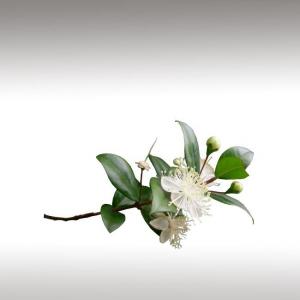

Botanical Name: Myrtus communis
Common Method of Extraction: Steam distilled
Part Typically Used: Leaves and twigs
Color: Pale yellow to orange
Consistency: Light/Thin
Perfumery Note: Top/middle
Strength of Initial Aroma: Fresh, sweet, camphoraceous
Myrtus Communis is also referred to as Common Myrtle or True Myrtle. Derived from Latin, the word means "Chaste Beauty".
Myrtus Communis, is a native shrub in the Middle East. It grows in all the countries that border the Mediterranean. Countries where Myrtle is native include: Turkey, Morocco, Algeria, Tunisia, France, Spain, Greece, and Italy. It has been brought to southern Britain and southern France.
The plant is an evergreen shrub or small tree, growing to 5 metres tall. The leaf is entire, 3 - 5 cm long, with a fragrant essential oil.
Myrtle essential oil comes from a small tree with many tough slender boughs. It has a brownish red bark with small pointed leaves. It produces flowers which turn into black berries: both the flowers and leaves are very fragrant.
The oil can be extracted from the leaves, branches, and berries. The oil that is most commonly used medicinally is extracted from the leaves. This oil will be liquid at room temperature. The color will range from clear to greenish - yellow to yellow - very - light - orange. Its aroma is reminiscent of Frankincense or bay. Some examples of Myrtle oil have a slight hint of Camphor or Eucalyptus. The oil from the Myrtle berries is used as a flavoring for drinks and alcoholic beverages throughout the Mediterranean Area.
The Myrtle plant first appears in history in ancient Greece, and it was associated with Aphrodite, the Goddess of Love and Beauty. Furthermore, the bravest soldiers, athletes and nobles were honored with its leaves.
At the Veneralia, women bathed wearing crowns woven of Myrtle branches, and Myrtle was used in wedding rituals. In the Aeneid, Myrtle marks the grave of the murdered Polydorus in Thrace.
Neo-pagan and wicca rituals, Myrtle, though not indigenous beyond the Mediterranean Basin, is now commonly associated with and sacred to Beltane (May Day).
Common Method of Extraction: Steam distilled
Part Typically Used: Leaves and twigs
Color: Pale yellow to orange
Consistency: Light/Thin
Perfumery Note: Top/middle
Strength of Initial Aroma: Fresh, sweet, camphoraceous
Myrtus Communis is also referred to as Common Myrtle or True Myrtle. Derived from Latin, the word means "Chaste Beauty".
Myrtus Communis, is a native shrub in the Middle East. It grows in all the countries that border the Mediterranean. Countries where Myrtle is native include: Turkey, Morocco, Algeria, Tunisia, France, Spain, Greece, and Italy. It has been brought to southern Britain and southern France.
The plant is an evergreen shrub or small tree, growing to 5 metres tall. The leaf is entire, 3 - 5 cm long, with a fragrant essential oil.
Myrtle essential oil comes from a small tree with many tough slender boughs. It has a brownish red bark with small pointed leaves. It produces flowers which turn into black berries: both the flowers and leaves are very fragrant.
The oil can be extracted from the leaves, branches, and berries. The oil that is most commonly used medicinally is extracted from the leaves. This oil will be liquid at room temperature. The color will range from clear to greenish - yellow to yellow - very - light - orange. Its aroma is reminiscent of Frankincense or bay. Some examples of Myrtle oil have a slight hint of Camphor or Eucalyptus. The oil from the Myrtle berries is used as a flavoring for drinks and alcoholic beverages throughout the Mediterranean Area.
The Myrtle plant first appears in history in ancient Greece, and it was associated with Aphrodite, the Goddess of Love and Beauty. Furthermore, the bravest soldiers, athletes and nobles were honored with its leaves.
At the Veneralia, women bathed wearing crowns woven of Myrtle branches, and Myrtle was used in wedding rituals. In the Aeneid, Myrtle marks the grave of the murdered Polydorus in Thrace.
Neo-pagan and wicca rituals, Myrtle, though not indigenous beyond the Mediterranean Basin, is now commonly associated with and sacred to Beltane (May Day).
Submitted by OperaDreamhouse (March 26, 2015)
Frankincense Essential Oil (Boswellia Carterii) ☸ Essential oils ☸ Base / General
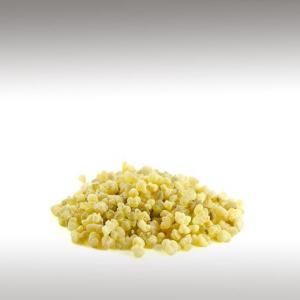

Botanical Name: Boswellia carterii
Common Method of Extraction: Steam distilled
Part Typically Used: Resin
Color: Light Yellow
Consistency: Thin
Perfumery Note: Base
Strength of Initial Aroma: Fresh, woody, spicy, balsamic with a citrus top note.
Frankincense, also called Olibanum, Levonah, Luban and Khunk, is an aromatic, congealed, resinous sap from a specific variety of trees in the genus Boswellia of the family Burseraceae.
Frankincense trees grow in regions of the world that are extremely dry and experience intense sunlight. Frankincense is harvested from Somalia or Oman.
The trees require an arid climate where moisture is provided by morning mist. The few ideal environments in the world for this small prized tree are found in Southern Arabia (Oman and Yemen), India, and Northern Africa (Somalia, Ethiopia, Eritrea and Kenya). Further, Frankincense trees require a limestone-rich soil and are mostly found growing on rocky hillsides and cliffs, or in the dried river beds below.
It originates from the Middle East, with abundant pinnacle leaves and has white or pale pink flowers. Deep incisions are made in the tree trunk and the bark peels off in narrow strips. Over weeks a milky juice exudes and hardens on contact with the air, resulting in an oleo gum resin, from which the oil is extracted by steam distillation.
The resin comes from inside the tree, under the bark. To collect Frankincense properly, a slow and carefully executed process must be followed. The process can only take place twice a year - once in the spring (March to May) and then again in the fall (September to October) and takes two weeks.
After all the process the crystalresin goes into the distillery where it is crushed into powder, put into an oil bath, and steam distilled to extract the oil from the crystal resin.
Frankincense quality is based on color, purity, aroma, age, and in some cases, where it is grown affects the quality. The first grade of Frankincense resin is the most common. It is a brownish resin that has a great deal of bark particles in it.
The resins such as Frankincense are known as sacred substances among many ancient and modern cultures. Boswellia Carterii the most typical and common Frankincense aroma, with a moderately strong terpenic top note and lovely pine heart notes.
One of the primary Frankincense varieties, Frankincense Carterii represents a fine balance of pleasing, fragrance sweetness and an important therapeutic profile. Frankincense essential oil smells sweeter, cleaner and fresher than the resin.
According to the latest scientific opinion both Boswellia Sacra and Boswellia Carteri are the same and should be correctly called Boswellia Sacra. Boswellia Sacra, produces the highest grade of Frankincense.
The tradition of caretaking Frankincense trees and harvesting their resin have played an important role in the life of nomadic desert tribes in North Africa for millennia. The trees are owned by families living in the area where they grow; ancient rituals surround the harvesting of the resin and the guardianship of the trees, which are passed on from generation to generation. Unfortunately, the traditions, customs and ceremonies surrounding Frankincense, like many other important plants, are being lost: as people embrace modern lifestyles, the old ways of caring for plants vanishes, and the plant's numerous benefits are lost.
Chemical structure:
This same complexity carries over to the chemical composition of the oil, which has over 200 individual natural chemicals that endow it with a complex aromatic bouquet and therapeutic profile. There is considerable variation in the proportion of these components depending on the micro-climate where the trees grow, the season at which the resin is harvested, and a number of other factors.
The gum resin of Frankincense contains Boswellic acids and other pentacyclic triterpens, which have a chemical structure that closely resembels that of steroids.
Common Method of Extraction: Steam distilled
Part Typically Used: Resin
Color: Light Yellow
Consistency: Thin
Perfumery Note: Base
Strength of Initial Aroma: Fresh, woody, spicy, balsamic with a citrus top note.
Frankincense, also called Olibanum, Levonah, Luban and Khunk, is an aromatic, congealed, resinous sap from a specific variety of trees in the genus Boswellia of the family Burseraceae.
Frankincense trees grow in regions of the world that are extremely dry and experience intense sunlight. Frankincense is harvested from Somalia or Oman.
The trees require an arid climate where moisture is provided by morning mist. The few ideal environments in the world for this small prized tree are found in Southern Arabia (Oman and Yemen), India, and Northern Africa (Somalia, Ethiopia, Eritrea and Kenya). Further, Frankincense trees require a limestone-rich soil and are mostly found growing on rocky hillsides and cliffs, or in the dried river beds below.
It originates from the Middle East, with abundant pinnacle leaves and has white or pale pink flowers. Deep incisions are made in the tree trunk and the bark peels off in narrow strips. Over weeks a milky juice exudes and hardens on contact with the air, resulting in an oleo gum resin, from which the oil is extracted by steam distillation.
The resin comes from inside the tree, under the bark. To collect Frankincense properly, a slow and carefully executed process must be followed. The process can only take place twice a year - once in the spring (March to May) and then again in the fall (September to October) and takes two weeks.
After all the process the crystalresin goes into the distillery where it is crushed into powder, put into an oil bath, and steam distilled to extract the oil from the crystal resin.
Frankincense quality is based on color, purity, aroma, age, and in some cases, where it is grown affects the quality. The first grade of Frankincense resin is the most common. It is a brownish resin that has a great deal of bark particles in it.
The resins such as Frankincense are known as sacred substances among many ancient and modern cultures. Boswellia Carterii the most typical and common Frankincense aroma, with a moderately strong terpenic top note and lovely pine heart notes.
One of the primary Frankincense varieties, Frankincense Carterii represents a fine balance of pleasing, fragrance sweetness and an important therapeutic profile. Frankincense essential oil smells sweeter, cleaner and fresher than the resin.
According to the latest scientific opinion both Boswellia Sacra and Boswellia Carteri are the same and should be correctly called Boswellia Sacra. Boswellia Sacra, produces the highest grade of Frankincense.
The tradition of caretaking Frankincense trees and harvesting their resin have played an important role in the life of nomadic desert tribes in North Africa for millennia. The trees are owned by families living in the area where they grow; ancient rituals surround the harvesting of the resin and the guardianship of the trees, which are passed on from generation to generation. Unfortunately, the traditions, customs and ceremonies surrounding Frankincense, like many other important plants, are being lost: as people embrace modern lifestyles, the old ways of caring for plants vanishes, and the plant's numerous benefits are lost.
Chemical structure:
This same complexity carries over to the chemical composition of the oil, which has over 200 individual natural chemicals that endow it with a complex aromatic bouquet and therapeutic profile. There is considerable variation in the proportion of these components depending on the micro-climate where the trees grow, the season at which the resin is harvested, and a number of other factors.
The gum resin of Frankincense contains Boswellic acids and other pentacyclic triterpens, which have a chemical structure that closely resembels that of steroids.
Submitted by OperaDreamhouse (March 26, 2015)
Galbanum Essential Oil (Ferula Galbaniflua) ☸ Essential oils ☸ Base / General
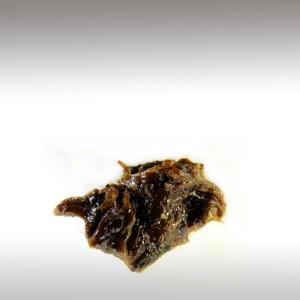

Botanical Name: Ferula galbaniflua
Common Method of Extraction: Steam distilled
Part Typically Used: Oleo gum resin
Color: Pale yellow
Consistency: Thin, Viscous
Perfumery Note: Top
Strength of Initial Aroma: Fresh earthy and woody aroma with green and spicy odor.
Galbanum essential oil brings pleasure to both the mind and soul.
Galbanum is a resinous gum obtained from some species of Ferula, a family of perennial giant fennels. The Ferula Galbaniflua plant has the typical umbrella flower and seed head of it’s more familiar relatives, a thick stalk, and can grow to about 2 m in height. It is native to southern Europe, North Africa and western Asia.
Galbanum is an aromatic gum resin, the product of certain umbelliferous Persian plant species. Galbanum - yielding plants grow plentifully on the slopes of the mountain ranges of northern Iran.
The entire plant is full of a milky resin substance, and when cut it oozes. The resin hardens and then is collected. Although they are sometimes referred to as giant fennel, they are different than Fennel.
To obtain the resinous gum, incisions are made in the stalk near the roots, from which the gum runs like brown tears. This is sometimes viscous, sometimes dry, depending on the species.
Galbanum has been used through out history as incense, medicine, and perfume. It is mentioned in the Bible in the Book of Exodus as a sweet spice that is made to a perfume for the Tabernacle, ancient Greek and Roman civilizations used it for it's fragrance and medicinal qualities.
The secret of using Galbanum successfully in an Aromatherapy blend is to use very little, as often one drop may be almost too much.
The best tears are palish externally and about the size of a Hazel Nut and when broken open are composed of clear white tears.
Distilled with water it yields a quantity of essential oil, about 6 drachms, to 1 lb. of gum. It was well known to the ancients and Pliny called it "Bubonion". Galbanum under dry distillation yields a thick oil of a bluish colour, which after purification becomes the blue colour of the oil obtained from the flowers of Matricaria Chamomilla.
Chemical structure:
It contains about 8%terpenes: about 65% of a resin which contains sulfur: about 20% gum: and a very small quantity of the colorless crystalline substance umbelliferone. It also contains a-pinene, b-pinene, limonene, cadinene, 3-carene, and ocimene.
Common Method of Extraction: Steam distilled
Part Typically Used: Oleo gum resin
Color: Pale yellow
Consistency: Thin, Viscous
Perfumery Note: Top
Strength of Initial Aroma: Fresh earthy and woody aroma with green and spicy odor.
Galbanum essential oil brings pleasure to both the mind and soul.
Galbanum is a resinous gum obtained from some species of Ferula, a family of perennial giant fennels. The Ferula Galbaniflua plant has the typical umbrella flower and seed head of it’s more familiar relatives, a thick stalk, and can grow to about 2 m in height. It is native to southern Europe, North Africa and western Asia.
Galbanum is an aromatic gum resin, the product of certain umbelliferous Persian plant species. Galbanum - yielding plants grow plentifully on the slopes of the mountain ranges of northern Iran.
The entire plant is full of a milky resin substance, and when cut it oozes. The resin hardens and then is collected. Although they are sometimes referred to as giant fennel, they are different than Fennel.
To obtain the resinous gum, incisions are made in the stalk near the roots, from which the gum runs like brown tears. This is sometimes viscous, sometimes dry, depending on the species.
Galbanum has been used through out history as incense, medicine, and perfume. It is mentioned in the Bible in the Book of Exodus as a sweet spice that is made to a perfume for the Tabernacle, ancient Greek and Roman civilizations used it for it's fragrance and medicinal qualities.
The secret of using Galbanum successfully in an Aromatherapy blend is to use very little, as often one drop may be almost too much.
The best tears are palish externally and about the size of a Hazel Nut and when broken open are composed of clear white tears.
Distilled with water it yields a quantity of essential oil, about 6 drachms, to 1 lb. of gum. It was well known to the ancients and Pliny called it "Bubonion". Galbanum under dry distillation yields a thick oil of a bluish colour, which after purification becomes the blue colour of the oil obtained from the flowers of Matricaria Chamomilla.
Chemical structure:
It contains about 8%terpenes: about 65% of a resin which contains sulfur: about 20% gum: and a very small quantity of the colorless crystalline substance umbelliferone. It also contains a-pinene, b-pinene, limonene, cadinene, 3-carene, and ocimene.
Submitted by OperaDreamhouse (March 26, 2015)
Basil Essential Oil (Ocimum Basilicum) ☸ Essential oils ☸ Base / General
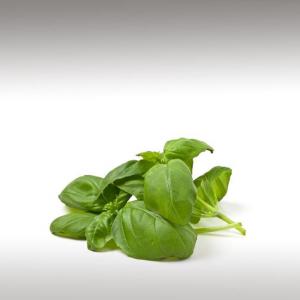

Botanical Name: Ocimum basilicum
Common Method of Extraction: Steam distillation
Part Typically Used: Flowering plant (Leaves and Flowers/Buds)
Color: Clear
Consistency: Thin
Perfumery Note: Top
Strength of Initial Aroma: Fresh, warm, spicy, herbaceous
Basil, Thai basil, or Sweet basil, is a common name for the culinary herb Ocimum basilicum of the family Lamiaceae (mints), sometimes known as Saint Joseph's Wort in some English-speaking countries.
Basil is possibly native to India, and has been cultivated there for more than 5,000 years. A much favored herb in India, it is held sacred to Krishna and Vishnu, and the leaves are even chewed before taking part in religious ceremonies.
The word Basil comes from the Greek (basileus), meaning "King", as it has come to be associated with the Feast of the Cross commemorating the finding of the True Cross by St. Helena, mother of the emperor Constantine I. Basil is still considered the "King of herbs" by many cookery authors.
Depending on the species and cultivar, the leaves may taste somewhat like anise, with a strong, pungent, often sweet smell.
Basil grows between 30 - 130 centimeters tall, with opposite, light green, silky leaves 3 - 11 centimeters long. The flowers are small, white in color and arranged in a terminal spike. Basil is very sensitive to cold, with best growth in hot, dry conditions. It behaves as an annual if there is any chance of a frost. Grows best in strong sunlight.
Once a stem produces flowers, foliage production stops on that stem, the stem becomes woody, and essential oil production declines. To prevent this, a Basil-grower may pinch off any flower stems before they are fully mature. Because only the blooming stem is so affected, some stems can be pinched for leaf production, while others are left to bloom for decoration or seeds.
Chemical structure:
The various Basil have such different scents because the herb has a number of different essential oils that come together in different proportions for various breeds. The strong clove scent of Sweet basil is derived from eugenol.
The chemical composition of Basil essential oil can vary greatly between varieties, batches and suppliers. Ideally, look for Basil essential oil that has a a significant percentage of linalooland that is weak in methyl chavicol (Estragole), a suspected carcinogen. Basil oils that are higher in linalool tend to have a more appealing aroma. Additionally, linalool is said to act as an insect repellent.
Common Method of Extraction: Steam distillation
Part Typically Used: Flowering plant (Leaves and Flowers/Buds)
Color: Clear
Consistency: Thin
Perfumery Note: Top
Strength of Initial Aroma: Fresh, warm, spicy, herbaceous
Basil, Thai basil, or Sweet basil, is a common name for the culinary herb Ocimum basilicum of the family Lamiaceae (mints), sometimes known as Saint Joseph's Wort in some English-speaking countries.
Basil is possibly native to India, and has been cultivated there for more than 5,000 years. A much favored herb in India, it is held sacred to Krishna and Vishnu, and the leaves are even chewed before taking part in religious ceremonies.
The word Basil comes from the Greek (basileus), meaning "King", as it has come to be associated with the Feast of the Cross commemorating the finding of the True Cross by St. Helena, mother of the emperor Constantine I. Basil is still considered the "King of herbs" by many cookery authors.
Depending on the species and cultivar, the leaves may taste somewhat like anise, with a strong, pungent, often sweet smell.
Basil grows between 30 - 130 centimeters tall, with opposite, light green, silky leaves 3 - 11 centimeters long. The flowers are small, white in color and arranged in a terminal spike. Basil is very sensitive to cold, with best growth in hot, dry conditions. It behaves as an annual if there is any chance of a frost. Grows best in strong sunlight.
Once a stem produces flowers, foliage production stops on that stem, the stem becomes woody, and essential oil production declines. To prevent this, a Basil-grower may pinch off any flower stems before they are fully mature. Because only the blooming stem is so affected, some stems can be pinched for leaf production, while others are left to bloom for decoration or seeds.
Chemical structure:
The various Basil have such different scents because the herb has a number of different essential oils that come together in different proportions for various breeds. The strong clove scent of Sweet basil is derived from eugenol.
The chemical composition of Basil essential oil can vary greatly between varieties, batches and suppliers. Ideally, look for Basil essential oil that has a a significant percentage of linalooland that is weak in methyl chavicol (Estragole), a suspected carcinogen. Basil oils that are higher in linalool tend to have a more appealing aroma. Additionally, linalool is said to act as an insect repellent.
Submitted by OperaDreamhouse (March 25, 2015)
Palo Santo Essential Oil (Bursera Graveolens) ☸ Essential oils ☸ Spiritual Practises
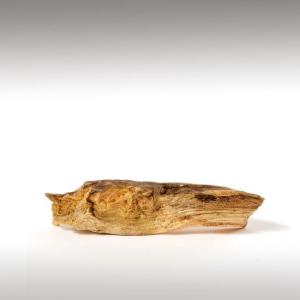

Palo Santo essential oil was used during the time of the Incas for its reputed spiritual purifying properties.
This tree inhabits the South American Gran Chaco region (Northern Argentina, Paraguay, Bolivia and the Brazilian Mato Grosso). Palo Santo is used by medicine-men and shamans at Ayahuasca ceremonies, rituals, healing and cleansing sessions. It has a surprisingly strong and sweet smell when burned, which is why palo santo is used as incense.
Palo Santo is used in South America in much the same way as White Ceremonial Sage is used in North America - to combat negative energy and to cleanse the space.
Palo Santo has been used for hundreds of years by native shamans for spiritual applications. For those that integrate essential oils within meditation, prayer or other spiritual applications, Palo Santo is an oil to pay close attention to.
It is important oil for use in Chakra applications. Opens the Third Eye and Crown Chakras.
This tree inhabits the South American Gran Chaco region (Northern Argentina, Paraguay, Bolivia and the Brazilian Mato Grosso). Palo Santo is used by medicine-men and shamans at Ayahuasca ceremonies, rituals, healing and cleansing sessions. It has a surprisingly strong and sweet smell when burned, which is why palo santo is used as incense.
Palo Santo is used in South America in much the same way as White Ceremonial Sage is used in North America - to combat negative energy and to cleanse the space.
Palo Santo has been used for hundreds of years by native shamans for spiritual applications. For those that integrate essential oils within meditation, prayer or other spiritual applications, Palo Santo is an oil to pay close attention to.
It is important oil for use in Chakra applications. Opens the Third Eye and Crown Chakras.
Submitted by OperaDreamhouse (March 25, 2015)
Anise Seed Essential Oil (Pimpinella Anisum) ☸ Essential oils ☸ Base / General
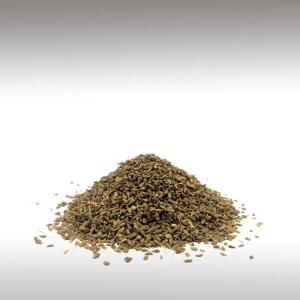

Botanical Name: Pimpinella anisum
Common Method of Extraction: Steam distillation
Part Typically Used: Seed
Color: Clear
Consistency: Thin
Perfumery Note: Middle
Strength of Initial Aroma: Fresh, sweet, spicy, licorice-like
Do not confuse Anise seed oil (Pimpinella anisum) with Anise Star oil (Illicium verum) which is produced from the fruit of a tree.
Anise (Pimpinella anisum), also called Aniseed, is a flowering plant in the family Apiaceae native to the eastern Mediterranean region and Southwest Asia. Its flavor has similarities with some other spices, such as star anise, fennel, and liquorice.
In this country Anise has been in use since the fourteenth century, and has been cultivated in English gardens from the middle of the sixteenth century, but it ripens its seeds here only in very warm summers, and it is chiefly in warmer districts that it is grown on a commercial scale, Southern Russia, Bulgaria, Germany, Malta, Spain, Italy, North Africa and Greece producing large quantities. It has also been introduced into India and South America.
Anise is one of the herbs that was supposed to avert the Evil Eye.
Anise is a herbaceous annual plant growing to 0,9 m or more tall. The flowers are white, approximately 3 mm in diameter, produced in dense umbels. The fruit is an oblong dry schizocarp 3–6 mm long, usually called "Aniseed".
Anise plants grow best in light, fertile, well-drained soil. The seeds should be planted as soon as the ground warms up in spring. It has a pungent liquorice-like smell and is also known as Anise and Sweet cumin.
The fruit, or so-called seeds. When threshed out, the seeds may be easily dried in trays, in a current of air in half-shade, out-of-doors, or by moderate heat. When dry, they are greyish brown, ovate, hairy, about one-fifth of an inch long, with ten crenate ribs and often have the stalk attached. They should be free from earthy matter. The taste is sweet and spicy, and the odour aromatic and agreeable.
Essential oil yielded by distillation is generally around 2-3% and anethole makes up 80-90% of this.
Common Method of Extraction: Steam distillation
Part Typically Used: Seed
Color: Clear
Consistency: Thin
Perfumery Note: Middle
Strength of Initial Aroma: Fresh, sweet, spicy, licorice-like
Do not confuse Anise seed oil (Pimpinella anisum) with Anise Star oil (Illicium verum) which is produced from the fruit of a tree.
Anise (Pimpinella anisum), also called Aniseed, is a flowering plant in the family Apiaceae native to the eastern Mediterranean region and Southwest Asia. Its flavor has similarities with some other spices, such as star anise, fennel, and liquorice.
In this country Anise has been in use since the fourteenth century, and has been cultivated in English gardens from the middle of the sixteenth century, but it ripens its seeds here only in very warm summers, and it is chiefly in warmer districts that it is grown on a commercial scale, Southern Russia, Bulgaria, Germany, Malta, Spain, Italy, North Africa and Greece producing large quantities. It has also been introduced into India and South America.
Anise is one of the herbs that was supposed to avert the Evil Eye.
Anise is a herbaceous annual plant growing to 0,9 m or more tall. The flowers are white, approximately 3 mm in diameter, produced in dense umbels. The fruit is an oblong dry schizocarp 3–6 mm long, usually called "Aniseed".
Anise plants grow best in light, fertile, well-drained soil. The seeds should be planted as soon as the ground warms up in spring. It has a pungent liquorice-like smell and is also known as Anise and Sweet cumin.
The fruit, or so-called seeds. When threshed out, the seeds may be easily dried in trays, in a current of air in half-shade, out-of-doors, or by moderate heat. When dry, they are greyish brown, ovate, hairy, about one-fifth of an inch long, with ten crenate ribs and often have the stalk attached. They should be free from earthy matter. The taste is sweet and spicy, and the odour aromatic and agreeable.
Essential oil yielded by distillation is generally around 2-3% and anethole makes up 80-90% of this.
Submitted by OperaDreamhouse (March 24, 2015)
Benzoin Essential Oil (Styrax Benzoin) ☸ Essential oils ☸ Base / General
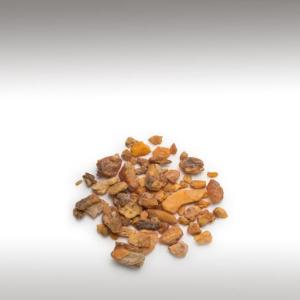

Botanical Name: Styrax benzoin
Common Method of Extraction: Solvent Extracted
Part Typically Used: Resin
Color: Golden brown
Consistency: Thick Viscosity
Perfumery Note: Base
Strength of Initial Aroma: Sweet, warm and vanilla-like aroma
Styrax benzoin is a tree which originated in Laos and Vietnam, but now grows in and around Malaysia, Java and Sumatra.
Styrax benzoin is a species of tree native to Sumatra in Indonesia. Common names for the tree include gum benjamin tree, loban, kemenyan, onycha, and Sumatra benzoin tree. It is a common member of the forests of Sumatra, where it grows to about 15 meters in maximum height.
Benzoin is the gum resin which exudes from the bark after tapping and the trees can apparently produce resin in this way for about 15 to 20 years.
Benzoin oil is extracted from resin of the Styrax benzoin tree and belongs to the Stryracaceae family. The tree is from Java, Sumatra and Thailand and grows to 8 meters. Deep incisions are made in the trunk of the tree, from which the grayish colored sap exudes. When the resinous lump becomes hard and brittle, it is collected from the bark.
When incisions are made in the trunk of the tree it exudes a balsamic liquid which solidifies after exposure to air and sunlight, resulting in a reddish-brown gum. The balsamic liquid collects as "tears" beneath the bark or around the incision cuts and although it is known as a gum, it is actually a balsamic resin.
The oil is extracted from the balsamic resin by means of a solvent, and because the resulting resinoid is still too viscous (thick) to work with at this stage, a diluent is added to the resinoid to make it mobile and easier to use. After this process, the oil is referred to as a resinoid. The resulting oil has a balsamic, creamy aroma reminiscent of vanilla due the presence of a component called vanillin, which also occurs in vanilla.
Benzoin oil has been in use for thousands of years ago instances have been found of its use in some of the oldest civilizations of the world, particularly in their religious ceremonies. Benzoin, also known as gum Benjamin, is one of the classic ingredients of incense.
From early records we know benzoin resin was imported by the Chinese and the ancient Egyptians via the Red Sea. Papyrus records indicate that it was ground into powder and mixed with other substances such as pine, juniper, galbanum, cypress and labdanum into incense, and often made into cones that were placed on the heads of Egyptian dancers.
The Ancient Greeks and Romans knew benzoin, although they called it by quite different names - "Silphion" to the Greeks, and "Laserpitium" to the Romans. They would include the powdered resin in pot-pourris because of its very powerful fixative properties.
In England its use was first recorded between the 15th and 16th centuries when it was brought over by spice traders and used in powdered form to make dry perfumes, one of which was worn by Queen Elizabeth I.
The Portuguese navigator, Barboza, is thought to have introduced the precious resin to Europe. Later, in 1623, the resin’s properties were sufficiently valued for the British to set up a factory in Siam to produce and export it.
Chemical structure:
Benzoin has a number of chemical components, such as benzoic, cinnamic acids, benzyl benzoate, benzoic aldehyde, vanillin and coniferyl benzoate.
Common Method of Extraction: Solvent Extracted
Part Typically Used: Resin
Color: Golden brown
Consistency: Thick Viscosity
Perfumery Note: Base
Strength of Initial Aroma: Sweet, warm and vanilla-like aroma
Styrax benzoin is a tree which originated in Laos and Vietnam, but now grows in and around Malaysia, Java and Sumatra.
Styrax benzoin is a species of tree native to Sumatra in Indonesia. Common names for the tree include gum benjamin tree, loban, kemenyan, onycha, and Sumatra benzoin tree. It is a common member of the forests of Sumatra, where it grows to about 15 meters in maximum height.
Benzoin is the gum resin which exudes from the bark after tapping and the trees can apparently produce resin in this way for about 15 to 20 years.
Benzoin oil is extracted from resin of the Styrax benzoin tree and belongs to the Stryracaceae family. The tree is from Java, Sumatra and Thailand and grows to 8 meters. Deep incisions are made in the trunk of the tree, from which the grayish colored sap exudes. When the resinous lump becomes hard and brittle, it is collected from the bark.
When incisions are made in the trunk of the tree it exudes a balsamic liquid which solidifies after exposure to air and sunlight, resulting in a reddish-brown gum. The balsamic liquid collects as "tears" beneath the bark or around the incision cuts and although it is known as a gum, it is actually a balsamic resin.
The oil is extracted from the balsamic resin by means of a solvent, and because the resulting resinoid is still too viscous (thick) to work with at this stage, a diluent is added to the resinoid to make it mobile and easier to use. After this process, the oil is referred to as a resinoid. The resulting oil has a balsamic, creamy aroma reminiscent of vanilla due the presence of a component called vanillin, which also occurs in vanilla.
Benzoin oil has been in use for thousands of years ago instances have been found of its use in some of the oldest civilizations of the world, particularly in their religious ceremonies. Benzoin, also known as gum Benjamin, is one of the classic ingredients of incense.
From early records we know benzoin resin was imported by the Chinese and the ancient Egyptians via the Red Sea. Papyrus records indicate that it was ground into powder and mixed with other substances such as pine, juniper, galbanum, cypress and labdanum into incense, and often made into cones that were placed on the heads of Egyptian dancers.
The Ancient Greeks and Romans knew benzoin, although they called it by quite different names - "Silphion" to the Greeks, and "Laserpitium" to the Romans. They would include the powdered resin in pot-pourris because of its very powerful fixative properties.
In England its use was first recorded between the 15th and 16th centuries when it was brought over by spice traders and used in powdered form to make dry perfumes, one of which was worn by Queen Elizabeth I.
The Portuguese navigator, Barboza, is thought to have introduced the precious resin to Europe. Later, in 1623, the resin’s properties were sufficiently valued for the British to set up a factory in Siam to produce and export it.
Chemical structure:
Benzoin has a number of chemical components, such as benzoic, cinnamic acids, benzyl benzoate, benzoic aldehyde, vanillin and coniferyl benzoate.
Submitted by OperaDreamhouse (March 24, 2015)
Palo Santo Essential Oil (Bursera Graveolens) ☸ Essential oils ☸ Base / General


Botanical Name: Bursera graveolens
Common Method of Extraction: Steam distilled
Part Typically Used: Dead heartwood
Color: Clear - Pale Yellow
Consistency: Thin
Perfumery Note: Middle
Strength of Initial Aroma: Sweet, woody, citrusy and slightly minty. Reminiscent of Frankincense.
Palo Santo is common today as a type of incense. Palo Santo Oil or “Holy Wood” is a very spiritual essential oil.
Bursera graveolens is a wild tree native from Mexico and the Yucatán Peninsula to Peru and Venezuela that inhabits the South American Gran Chaco region. It is also found in Costa Rica, El Salvador, Guatemala, Honduras, Colombia, Ecuador, Peru and on the Galapagos islands.
The tree belongs to the same family (Burseraceae) as Frankincense and Myrrh. Palo Santo (or Palosanto) is used for crafting objects and to produce burning sticks: however, production ofessential oilis attracting most of the modern interest. Chemical composition, as reflected by aroma, is variable.
The essential oil is distilled from the heartwood of the Palo Santo tree. It is fascinating that the heartwoodmust be at least two years old and be from the red wood to produce the higher quality oil. The longer the tree has been dead, the more powerful the oil (This also holds true for Frankincense essential oil).
The use of Palo Santo from Bursera Graveolens is traditional in South America, especially in Ecuador. According to the local customs, it is used against the "Mala Energía" (Bad energy).
In Ecuador it is against the law to remove or cut down Palo Santo trees as they are protected. Additionally, even taking the dead trees has limitations and must be permitted through the government. So, there are very few companies that are permitted to even touch the trees, more or less produce the essential oil.
These are protected, one thousand year old trees from which the windfall is collected from the ground and considered sacred by the indigenous peoples for many generations.
Tree grows for about 40 years and then dies. Then, it has to lay down for about 10 more years before people can process it.
The essential oil of the Palo Santo tree has many applications in aromatherapy.
Chemical structure:
Aged heartwood is rich in terpenes such as limonene and α-terpineol.
Animal studies show that d-limonene is contained in the peels of Citrus fruits such as Grapefruit, Orange and Lemon. It is a powerful antioxidant.
Common Method of Extraction: Steam distilled
Part Typically Used: Dead heartwood
Color: Clear - Pale Yellow
Consistency: Thin
Perfumery Note: Middle
Strength of Initial Aroma: Sweet, woody, citrusy and slightly minty. Reminiscent of Frankincense.
Palo Santo is common today as a type of incense. Palo Santo Oil or “Holy Wood” is a very spiritual essential oil.
Bursera graveolens is a wild tree native from Mexico and the Yucatán Peninsula to Peru and Venezuela that inhabits the South American Gran Chaco region. It is also found in Costa Rica, El Salvador, Guatemala, Honduras, Colombia, Ecuador, Peru and on the Galapagos islands.
The tree belongs to the same family (Burseraceae) as Frankincense and Myrrh. Palo Santo (or Palosanto) is used for crafting objects and to produce burning sticks: however, production ofessential oilis attracting most of the modern interest. Chemical composition, as reflected by aroma, is variable.
The essential oil is distilled from the heartwood of the Palo Santo tree. It is fascinating that the heartwoodmust be at least two years old and be from the red wood to produce the higher quality oil. The longer the tree has been dead, the more powerful the oil (This also holds true for Frankincense essential oil).
The use of Palo Santo from Bursera Graveolens is traditional in South America, especially in Ecuador. According to the local customs, it is used against the "Mala Energía" (Bad energy).
In Ecuador it is against the law to remove or cut down Palo Santo trees as they are protected. Additionally, even taking the dead trees has limitations and must be permitted through the government. So, there are very few companies that are permitted to even touch the trees, more or less produce the essential oil.
These are protected, one thousand year old trees from which the windfall is collected from the ground and considered sacred by the indigenous peoples for many generations.
Tree grows for about 40 years and then dies. Then, it has to lay down for about 10 more years before people can process it.
The essential oil of the Palo Santo tree has many applications in aromatherapy.
Chemical structure:
Aged heartwood is rich in terpenes such as limonene and α-terpineol.
Animal studies show that d-limonene is contained in the peels of Citrus fruits such as Grapefruit, Orange and Lemon. It is a powerful antioxidant.
Submitted by OperaDreamhouse (March 24, 2015)
Coconut Flakes (Cocos Nucifera) ☸ Ingredients ☸ Base / General
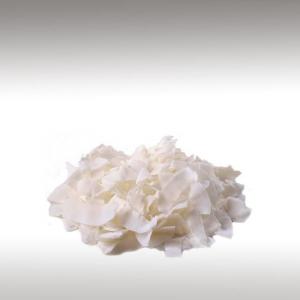

The Coconuts that drop from palm trees in tropical climates have enriched salads, curries and pies worldwide. Organic Coconut Flakes are made from dried and flaked Organic Coconut flesh. These are large Flakes that are popular in cereals, muesli & baking.
The unsweetened Coconut Flakes are a concentrated source of calories, which means they have a high-calorie content compared to their serving size. Now studies show that the medium chain fatty acids in Coconuts are not like other saturated fats. One, lauric acid, is the predominant fatty acid in mother's milk.
Shredded and flaked air-dried coconut can lose flavor. The best Flakes for a healthy diet are the freshest and most pure.
This premiumdried Coconut contains no additives or preservatives, and is not sweetened.
Chemical structure:
Coconut is classified as a “functional food” because it provides many health benefits over and beyond its already impressive nutritional content. Coconut contains high levels of lauric acid which is converted by the body into monolaurin. Monolaurin is responsible for solubilizing the lipid envelope of virus’s, causing the disintegration of the virus envelope and subsequent death of the virus.
Dried Coconuts are a good source of copper, zinc, magnesium, manganese, iron, B Vitamins and even calcium.
The unsweetened Coconut Flakes are a concentrated source of calories, which means they have a high-calorie content compared to their serving size. Now studies show that the medium chain fatty acids in Coconuts are not like other saturated fats. One, lauric acid, is the predominant fatty acid in mother's milk.
Shredded and flaked air-dried coconut can lose flavor. The best Flakes for a healthy diet are the freshest and most pure.
This premiumdried Coconut contains no additives or preservatives, and is not sweetened.
Chemical structure:
Coconut is classified as a “functional food” because it provides many health benefits over and beyond its already impressive nutritional content. Coconut contains high levels of lauric acid which is converted by the body into monolaurin. Monolaurin is responsible for solubilizing the lipid envelope of virus’s, causing the disintegration of the virus envelope and subsequent death of the virus.
Dried Coconuts are a good source of copper, zinc, magnesium, manganese, iron, B Vitamins and even calcium.
Submitted by OperaDreamhouse (March 9, 2015)
Marjoram Essential Oil (Origanum Majorana) ☸ Essential oils ☸ Base / General
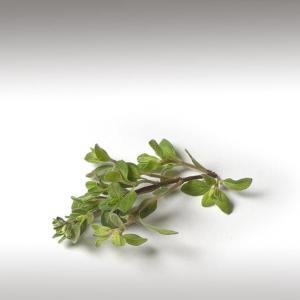

Botanical Name: Origanum majorana
Common Method of Extraction: Steam Distilled
Part Typically Used: Leaves and tops
Color: Yellowish in color (darkening to brown as it ages)
Consistency: Thin
Perfumery Note: Middle
Strength of Initial Aroma: Spicy,woody, warm and mildly camphorus aroma.
Marjoram (Origanum Majorana) is a somewhat cold-sensitive perennial herb or under shrub with sweet pine and citrus flavors. In some Middle-Eastern countries, Marjoram is synonymous with Oregano, and there the names Sweet marjoram and Knotted Marjoram are used to distinguish it from other plants of the genus Origanum.
It is native to the Mediterranean region, growing naturally in both central European and North African countries. Its original name comes from a greek word meaning "Joy of the Mountains".
This tender bushy perennial herb, about 60cm high, has a hairy stem, dark green oval leaves and small white or pink flowers. Originally from the Mediterranean region, the word "Origanum" is from the Greek word "Orosganos" meaning "Joy of the Mountain" and was given to newlyweds as token of good fortune.
The whole plant is highly aromatic, exuding a pleasing peppery, warm and fresh fragrance.
Sweet Marjoram is cultivated for the production of essential oil in Egypt, France, Germany, Hungary, Tunisia, Spain and more recently in the USA. In the south of France, harvesting usually takes place between August and September when the flowers are in full bloom. After collecting, the garbage is dried for several days and the stems removed before charging the still.
Marjoram is indigenous to Cyprus and southern Turkey, and was known to the Greeks and Romans as a symbol of happiness. The Greeks associated marjoram with Aphrodite, the Goddess of love, beauty and fertility.
It was also used in marriage ceremonies as it is sacred to Venus, her son Hymen and, even more anciently, to the Earth Goddess Ge (Gaia). The modern practitioner may use Marjoram to connect with the spirits of the ancestors or to communicate with a departed loved one. Marjoram was considered a "Lucky Plant", protective, spreading joy and bringing good fortune.
Marjoram spread far and wide reaching Egypt around 2000 BC, according to early records. The Egyptians dedicated Marjoram to the god of the underworld, Osiris, and it was used as a funerary herb as well as to produce unguents, medicines and even love potions.
Chemical structure:
It has many chemical components, some of which are borneol, camphor and pinene.
Marjoram oil is extracted from the fresh and dried leaves and flowering tops of the plant by steam distillation and yields 0.5 - 3 %.
Common Method of Extraction: Steam Distilled
Part Typically Used: Leaves and tops
Color: Yellowish in color (darkening to brown as it ages)
Consistency: Thin
Perfumery Note: Middle
Strength of Initial Aroma: Spicy,woody, warm and mildly camphorus aroma.
Marjoram (Origanum Majorana) is a somewhat cold-sensitive perennial herb or under shrub with sweet pine and citrus flavors. In some Middle-Eastern countries, Marjoram is synonymous with Oregano, and there the names Sweet marjoram and Knotted Marjoram are used to distinguish it from other plants of the genus Origanum.
It is native to the Mediterranean region, growing naturally in both central European and North African countries. Its original name comes from a greek word meaning "Joy of the Mountains".
This tender bushy perennial herb, about 60cm high, has a hairy stem, dark green oval leaves and small white or pink flowers. Originally from the Mediterranean region, the word "Origanum" is from the Greek word "Orosganos" meaning "Joy of the Mountain" and was given to newlyweds as token of good fortune.
The whole plant is highly aromatic, exuding a pleasing peppery, warm and fresh fragrance.
Sweet Marjoram is cultivated for the production of essential oil in Egypt, France, Germany, Hungary, Tunisia, Spain and more recently in the USA. In the south of France, harvesting usually takes place between August and September when the flowers are in full bloom. After collecting, the garbage is dried for several days and the stems removed before charging the still.
Marjoram is indigenous to Cyprus and southern Turkey, and was known to the Greeks and Romans as a symbol of happiness. The Greeks associated marjoram with Aphrodite, the Goddess of love, beauty and fertility.
It was also used in marriage ceremonies as it is sacred to Venus, her son Hymen and, even more anciently, to the Earth Goddess Ge (Gaia). The modern practitioner may use Marjoram to connect with the spirits of the ancestors or to communicate with a departed loved one. Marjoram was considered a "Lucky Plant", protective, spreading joy and bringing good fortune.
Marjoram spread far and wide reaching Egypt around 2000 BC, according to early records. The Egyptians dedicated Marjoram to the god of the underworld, Osiris, and it was used as a funerary herb as well as to produce unguents, medicines and even love potions.
Chemical structure:
It has many chemical components, some of which are borneol, camphor and pinene.
Marjoram oil is extracted from the fresh and dried leaves and flowering tops of the plant by steam distillation and yields 0.5 - 3 %.
Submitted by OperaDreamhouse (March 8, 2015)
Marjoram Essential Oil (Origanum Majorana) ☸ Essential oils ☸ Medicine / Health

 Children: Avoid using on children under 6 years.
Children: Avoid using on children under 6 years.
Submitted by OperaDreamhouse (March 8, 2015)
Marjoram Essential Oil (Origanum Majorana) ☸ Essential oils ☸ Spiritual Practises


Marjoram essential oil is mentally strengthening and relaxing. Calms the nervous tension. Spicy scent and woody.
The Greeks and the Romans associated Marjoram with transition through physical death.
Death is also a metaphor for transformation which is the key here. Therefore, those who are experiencing the opposite feelings such as disconnected, insecure, unsupported can transform those feelings with the assistance of Marjoram oil.
As we release negative feelings and we become more balanced, we are able to accept and love ourselves more fully and restore our power to ourselves.
Marjoram affects the heart and Solar Plexus Chakras.
The Greeks and the Romans associated Marjoram with transition through physical death.
Death is also a metaphor for transformation which is the key here. Therefore, those who are experiencing the opposite feelings such as disconnected, insecure, unsupported can transform those feelings with the assistance of Marjoram oil.
As we release negative feelings and we become more balanced, we are able to accept and love ourselves more fully and restore our power to ourselves.
Marjoram affects the heart and Solar Plexus Chakras.
Submitted by OperaDreamhouse (March 8, 2015)
Coconut Milk (Cocos Nucifera) ☸ Ingredients ☸ Base / General
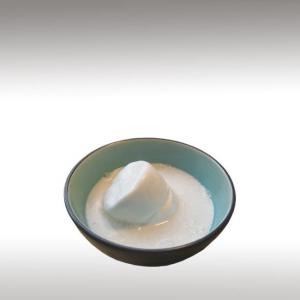

Coconut milk is the liquid that comes from the grated meat of abrown Coconut. It should not be confused with Coconut Water. The colour and rich taste of Coconut Milk can be attributed to the high oil content.
The best Coconut Milk is made from the pressing of fresh, ripe Coconut meat.
The grating process itself can be carried out manually or with a more modern grating machine. Several grades of coconut milk exist: from thick at 20 - 22% fat to thin at 5 - 7%. Thick Milk is prepared by directly squeezing grated Coconut meat through cheesecloth. The squeezed Coconut meat is then soaked in water and squeezed further to produce thin Coconut milk.
Coconut Milk can be made at home by processing grated Coconut with hot water or milk, which extracts the oil and aromatic compounds. It has then a fat content of 17 - 24% depending on the fat level of the Coconut meat and the quantity of added water.
Good Coconut Milk has a clean, white color, rich creamy taste and is mildly sweet with the essence of Coconut. Once opened, cans of Coconut Milk must be refrigerated and are usually only good for a few days.
From Thailand to Hawaii to the West Indies, Coconut Milk has served to nourish millions worldwide as the creamy cornerstone of their delicious regional dishes.
Chemical structure:
Coconut, traditionally eaten across the South Pacific and in parts of Asia, is a powerhouse of nutrients. It’s high in saturated fatty acids and medium-chain triglycerides (MCT), which are both easily burned as fuel by the body.
Coconut is a potent source of lauric acid - a deeply nourishing fat which is otherwise only available in human breast milk.
Fresh, homemade Coconut Milk is also richer in Vitamins, food enzymes and nutrients than Coconut Milk from a tin.
The best Coconut Milk is made from the pressing of fresh, ripe Coconut meat.
The grating process itself can be carried out manually or with a more modern grating machine. Several grades of coconut milk exist: from thick at 20 - 22% fat to thin at 5 - 7%. Thick Milk is prepared by directly squeezing grated Coconut meat through cheesecloth. The squeezed Coconut meat is then soaked in water and squeezed further to produce thin Coconut milk.
Coconut Milk can be made at home by processing grated Coconut with hot water or milk, which extracts the oil and aromatic compounds. It has then a fat content of 17 - 24% depending on the fat level of the Coconut meat and the quantity of added water.
Good Coconut Milk has a clean, white color, rich creamy taste and is mildly sweet with the essence of Coconut. Once opened, cans of Coconut Milk must be refrigerated and are usually only good for a few days.
From Thailand to Hawaii to the West Indies, Coconut Milk has served to nourish millions worldwide as the creamy cornerstone of their delicious regional dishes.
Chemical structure:
Coconut, traditionally eaten across the South Pacific and in parts of Asia, is a powerhouse of nutrients. It’s high in saturated fatty acids and medium-chain triglycerides (MCT), which are both easily burned as fuel by the body.
Coconut is a potent source of lauric acid - a deeply nourishing fat which is otherwise only available in human breast milk.
Fresh, homemade Coconut Milk is also richer in Vitamins, food enzymes and nutrients than Coconut Milk from a tin.
Indeed, fresh Coconut Milk contains three times as much Vitamin C as canned Coconut Milk and is richer in thiamin, niacin, Vitamin B6, folate and pantothenic acid. Moreover, fresh raw Coconut Milk contains Vitamin E, a heat-sensitive, fat-soluble Vitamin that is otherwise absent in canned Coconut Milk.
Submitted by OperaDreamhouse (March 7, 2015)
Coconut Milk (Cocos Nucifera) ☸ Ingredients ☸ Beauty / Cosmetics


Thick Milk is mainly used to make desserts as well as rich and dry sauces. Thin Coconut Milk is used for soups and general cooking.
How to make homemade Coconut Milk:
Ingredients:
2 brown coconuts
3 to 4 cups filtered water
Pierce the eyes of the Coconut with a sharp knife and drain Coconut water into a mixing bowl. Split the Coconuts by covering in a kitchen towel and smashing with a rolling pin or hammer.
With a sharp knife, pry the Coconut meat from its husk, then peel off any remaining brown bits of skin that adhere to the Coconut meat. Place the coconut flesh and Coconut water in a blender, adding three to four cups hot water blend until the Coconut and Water forms a smooth slurry.
Pour Coconut mixture through a butter muslin or nut milk bag into a mason jar or pitcher. Squeeze out as much liquid as possible, and transfer the Coconut Milk to the refrigerator.
How to make homemade Coconut Milk:
Ingredients:
2 brown coconuts
3 to 4 cups filtered water
Pierce the eyes of the Coconut with a sharp knife and drain Coconut water into a mixing bowl. Split the Coconuts by covering in a kitchen towel and smashing with a rolling pin or hammer.
With a sharp knife, pry the Coconut meat from its husk, then peel off any remaining brown bits of skin that adhere to the Coconut meat. Place the coconut flesh and Coconut water in a blender, adding three to four cups hot water blend until the Coconut and Water forms a smooth slurry.
Pour Coconut mixture through a butter muslin or nut milk bag into a mason jar or pitcher. Squeeze out as much liquid as possible, and transfer the Coconut Milk to the refrigerator.
Submitted by OperaDreamhouse (March 7, 2015)
Page 27 of 48

